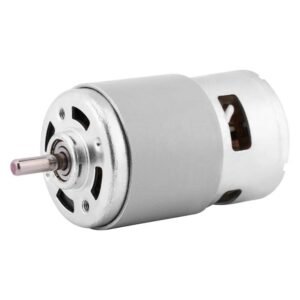Skip to content
1. Failure to Start
- Power not connected
- Use a multimeter to check the power supply circuit and electrical switches for proper connection and contact.
- Motor leads shorted or grounded
- Inspect for short circuits between the leads or grounding issues, and address any faults.
- Poor contact between brushes and commutator
- Check if the brushes are properly contacting the commutator. Ensure brushes move freely in their holders and the contact surface is adequate.
- Motor overload
- Reduce the load on the motor.
- Short circuit or open circuit in the field winding
- Check and measure the field winding, identify any short or open circuits, and repair as necessary.
- Polarity of some main poles reversed, canceling part of the main magnetic flux
- Inspect the polarity of the field coil’s main poles, find wiring errors, and correct them.
- Open circuit in the armature winding
- Measure the resistance of the armature, commutating winding, and compensating winding with a multimeter, locate the fault, and repair it.
2. Low or Uneven Running Speed
- Short circuit in the armature winding
- Identify the short circuit point in the armature winding and repair or replace it.
- Short circuit between commutator segments
- Check the commutator segments, clean out solder, copper shavings, and burrs between them, and eliminate any potential short circuits.
- Incorrect brush position
- Adjust the brush position.
- Incorrect polarity of the interpole winding, resulting in long yellow sparks on the commutator
- Correct the polarity of the interpole winding after confirming the wiring error.
- Power supply voltage too low
- Adjust the power supply voltage to the rated value.
3. Excessive Speed with Severe Sparking
- High resistance or open circuit in the field winding
- Check all terminals in the field winding circuit for poor contact due to oxidation and restore normal resistance.
- Short circuit between turns in the field winding
- Identify the extent of the short circuit and repair or replace the field winding as needed.
- Incorrect polarity of the shunt field winding
- Find the wiring error in the shunt field winding and reconnect it properly.
- Short circuit or open circuit in the armature winding
- Locate the fault in the armature winding and repair or replace it as necessary.
- Series motor underloaded
- Increase the load appropriately to ensure safe startup.
- Incorrect polarity in the series winding of a compound motor
- Check the series winding connections and correct any errors.
- Brush displacement from its original position
- Reinstall the brushes according to the original markings or use the inductive method to find the correct position.
4. Overheating of the Armature During Operation
- Motor overloaded or excessive startup frequency
- Reduce the load or decrease the frequency of startups.
- Short circuit or grounding fault in the armature winding
- Identify and repair the short circuit or grounding issue in the armature winding.
- Short circuit between commutator segments
- Remove solder, copper shavings, and burrs between commutator segments.
- Excessive pressure on the brushes causing abnormal heating of the commutator
- Adjust the brush spring pressure.
- Armature rubbing against the stator poles
- Check for loose bolts on the end covers or stator core and address any misalignment.
- Uneven air gap between the stator poles
- Inspect and adjust the air gap.
- Poor motor cooling
- Clean the dust filter and airways, and check the fan for defects.
- Low power supply voltage in shunt or compound motors
- Measure the supply voltage with a voltmeter and restore it to the rated value.



